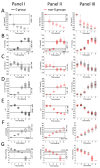An Insight into the Stages of Ion Leakage during Red Blood Cell Storage
- PMID: 33809183
- PMCID: PMC7998123
- DOI: 10.3390/ijms22062885
An Insight into the Stages of Ion Leakage during Red Blood Cell Storage
Abstract
Packed red blood cells (pRBCs), the most commonly transfused blood product, are exposed to environmental disruptions during storage in blood banks. In this study, temporal sequence of changes in the ion exchange in pRBCs was analyzed. Standard techniques commonly used in electrolyte measurements were implemented. The relationship between ion exchange and red blood cells (RBCs) morphology was assessed with use of atomic force microscopy with reference to morphological parameters. Variations observed in the Na+, K+, Cl-, H+, HCO3-, and lactate ions concentration show a complete picture of singly-charged ion changes in pRBCs during storage. Correlation between the rate of ion changes and blood group type, regarding the limitations of our research, suggested, that group 0 is the most sensitive to the time-dependent ionic changes. Additionally, the impact of irreversible changes in ion exchange on the RBCs membrane was observed in nanoscale. Results demonstrate that the level of ion leakage that leads to destructive alterations in biochemical and morphological properties of pRBCs depend on the storage timepoint.
Keywords: atomic force microscopy; membrane ions transport; red blood cell; red cell aging.
Conflict of interest statement
The authors declare no conflict of interest.
Figures




References
-
- Gevorkian S., Allahverdyan A., Gevorgyan D., Ma W.-J., Hu C.-K. Can morphological changes of erythrocytes be driven by hemoglobin? Phys. A Stat. Mech. Appl. 2018;508:608–612. doi: 10.1016/j.physa.2018.05.118. - DOI
-
- De Rosa M.C., Alinovi C.C., Galtieri A., Scatena R., Giardina B. The plasma membrane of erythrocytes plays a fundamental role in the transport of oxygen, carbon dioxide and nitric oxide and in the maintenance of the reduced state of the heme iron. Gene. 2007;398:162–171. doi: 10.1016/j.gene.2007.02.048. - DOI - PubMed
-
- Kuhn V., Diederich L., Keller T.S., Kramer C.M., Lückstädt W., Panknin C., Suvorava T., Isakson B.E., Kelm M., Cortese-Krott M.M. Red Blood Cell Function and Dysfunction: Redox Regulation, Nitric Oxide Metabolism, Anemia. Antioxid. Redox Signal. 2017;26:718–742. doi: 10.1089/ars.2016.6954. - DOI - PMC - PubMed
MeSH terms
Substances
Grants and funding
LinkOut - more resources
Full Text Sources
Other Literature Sources

